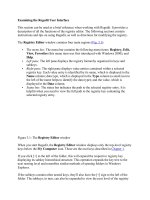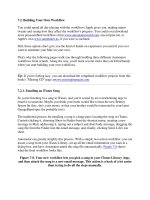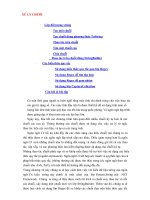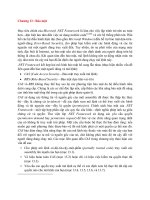The Sky at Night Phần 1 pdf
Bạn đang xem bản rút gọn của tài liệu. Xem và tải ngay bản đầy đủ của tài liệu tại đây (1.64 MB, 19 trang )
The Sky at Night
Patrick Moore
The Sky at Night
Patrick Moore
Farthings
39 West Street
Selsey, West Sussex PO20 9AD
UK
ISBN 978-1-4419-6408-3
e-ISBN 978-1-4419-6409-0
DOI 10.1007/978-1-4419-6409-0
Springer New York Dordrecht Heidelberg London
Library of Congress Control Number: 2010934379
© Springer Science+Business Media, LLC 2010
All rights reserved. This work may not be translated or copied in whole or in part without the written
permission of the publisher (Springer Science+Business Media, LLC, 233 Spring Street, New York, NY
10013, USA), except for brief excerpts in connection with reviews or scholarly analysis. Use in connection
with any form of information storage and retrieval, electronic adaptation, computer software, or by similar
or dissimilar methodology now known or hereafter developed is forbidden.
The use in this publication of trade names, trademarks, service marks, and similar terms, even if they are
not identified as such, is not to be taken as an expression of opinion as to whether or not they are subject
to proprietary rights.
Printed on acid-free paper
Springer is part of Springer Science+Business Media (www.springer.com)
Foreword
When I became the producer of the Sky at Night in 2002, I was given some friendly
advice: “It’s a quiet little programme, not much happens in astronomy.” How wrong
they were! It’s been a hectic and enthralling time ever since:, with missions arriving
at distant planets; new discoveries in our Universe; and leaps in technology, which
mean amateurs can take pictures as good as the Hubble Space Telescope.
What a privilege it is to work on a programme with such a huge heritage! I am
constantly amazed looking back at the flotilla of excellent programmes which have
gone out over the past five decades. The Sky at Night has always been at the sharp
end of science broadcasting, whether it’s showing the first view from the far side of
the Moon or pictures of a new comet which has swept into our sky. Viewers can
depend on Sir Patrick to tell them the latest news and explain what it means. It’s an
outstanding achievement and Sir Patrick still holds the world record for being the
same presenter on the longest running TV programme.
Our guests love coming down to Farthings, Sir Patrick’s home. For them, meeting him is like meeting their astronomical hero. Over the past five decades, the Sky
at Night has managed to talk to the space scientists and astronomers making the
landmark discoveries. No matter how busy they are, they make room for Sir Patrick.
We have been privileged to record astronomical history as it is made. For example,
when NASA’s spacecraft hits comet Tempel 1, the Sky at Night was given exclusive
access to film the astronomers using the Palomar Telescope, thanks to its Director,
Professor Richard Ellis.
I will never forget the night the Huygens probe landed on Saturn’s moon, Titan.
Professor John Zarnecki, Principal Investigator for the surface science package on
board Huygens, gave us the ‘nod’ to set up our camera in the dining room at ESA’s
mission control. The world’s media was camped out next to the press room, but we
trusted John and moved our camera. It paid off when the astronomers came rushing
in to us for an impromptu presentation of the first images of Titan, from a distance
of some 900 million miles.
Filming the Sky at Night every month is always a challenge. First, there is the setting of our main interview with Sir Patrick and the guests. To make room in Sir
Patrick’s study for our three cameras and lights, we have to clear much of his furniture
and move his work. I always try to make sure that the Woodstock typewriter is in shot.
Patrick still uses it for the programme scripts and, of course, his many books.
v
vi
Foreword
Secondly, there is the programme budget. I like to remind my BBC colleagues
that daytime TV programmes get more money than we do. We do not have the
money to commission CGI graphics; instead, we use simpler and much cheaper
props to explain complex theories. Professor Fred Watson rose to the challenge
when explaining the transit of Venus with a lemon and two hoops. Dr Dave Rothery
juggled coloured ping pong balls to great aplomb when discussing the formation of
the Solar System. Professors Carlos Frenk and Derek Ward-Thompson resorted to
dinner plates to illustrate the grand collision between our Galaxy and Andromeda.
When our dear friend Dr Allan Chapman from Oxford comes on the programme,
he always steals the show. He managed to cover Sir Patrick in sloppy plaster when
creating craters on the Moon. When Health and Safety said he couldn’t use sulphuric acid to recreate an historic Robert Hooke experiment about understanding comets, he used vinegar instead. The bubbles may not have been as explosive, but they
did the job! Another show stealer was comic and impersonator John Culshaw, who
became Patrick Moore from the year 1957 for our ‘Time Lord’ programme. Seeing
him adopt Patrick’s mannerisms, including the monocle, was quite unnerving. Sir
Patrick, in 2007, was more than happy to admit that Patrick Moore in 1957 had got
a few things wrong and told him so!
There are many people I would like to thank on behalf of the programme. First
and foremost are the viewers, who search the schedules for our monthly time slot
and stay up late to watch us. Without their loyalty and dedication, we would not
have had a programme. There are the amateur astronomers who share images and
observations, with their endless enthusiasm and good humour when the clouds role
in on our observing sessions; the BBC team who work behind the scenes and who
love the show, and put every effort to make it the best science programme that’s all
year round.
I would like to thank the other man who presents the programme, Dr Chris
Lintott. He has been with the programme since 2003, and reports from far flung
observatories, asking the astronomers all the right probing questions, and helping
me understand the complexities of the Cosmos.
Finally, there is Sir Patrick himself. The past few years have been the most exciting and most enjoyable period of my career. It’s been a pleasure and honour to work
with Sir Patrick. Every time I meet him, I am bowled over by the enormous breadth
of knowledge, grasp of the subject and his ability to explain it simply and succinctly. He is a wonderful broadcaster.
I look forward to many, many more Sky at Night programmes, with Sir Patrick
at the helm presenting the show, reminding us why we should step outside and look
up at the night sky. There is a whole universe out there, and Sir Patrick Moore is
going to tell us all about it.
Jane Fletcher
Producer, the Sky at Night
Introduction
This new book, the Sky at Night series is the 13th – I hope this is not an omen! It
covers an eventful period, and I hope that we have managed to cover it successfully.
It is interesting to look back to the early days of the Sky at Night; after all, our
programme goes back to before the start of the Space Age.
There has been one important change. Chris Lintott who helped me join as copresenter, now plays a more major role than I do – which is exactly how I planned
it. Unlike me, he is now a leading research astronomer. It is good to have him with
me, and he will still be around long after I have faded from view.
My special thanks go to Jane Fletcher (in private life Mrs Segar) for guiding the
programme throughout this period, and for masterminding that never-to-be-forgotten Fiftieth Anniversary.
Well, here’s to the next half-century …
Patrick Moore
vii
About the Author
Sir Patrick Moore is one of the world’s leading popularisers of astronomy. He has
written more than 100 books and presented his BBC TV programme The Sky at
Night every 4 weeks since 1957, making it the world’s longest running television
program of any kind.
While still in school, he became a member of the British Astronomical
Association (BAA) and was later appointed director of Brockhurst Observatory. He
served as director of the Armagh Planetarium between 1965 and 1968. He is a fellow of the Royal Astronomical Society (and a Jackson Gwillt medallist), a member
of the International Astronomical Union, a holder of the Goodacre medal, and former president and current vice president of the BAA. A minor planet (# 2602) has
been named after him. He was knighted in November 2000. He was also made a
Fellow of the Royal Society. As the presenter of the record-breaking The Sky at
Night series, Patrick was awarded a BAFTA in 2000.
The most important research Patrick has carried out has been about the Moon.
He is credited with independently discovering the Mare Orientale. He did this with
his “traditional” 12½-in. reflector, which still sits proudly in his front garden. His
maps of the Moon were among those used by the Russians in 1959 to correlate the
first Lunik 3 pictures of the far side. He was also at NASA for the lunar mapping
prior to the Apollo missions.
Chris Lintott, the co-star of the latest episodes of The Sky at Night, has a massive fan base that derives equally from The Sky at Night and from his paradigmshifting astronomy website Galaxy Zoo, which has some 150,000 members.
ix
Acknowledgements
My most grateful thanks to those who have joined me on the programme during this
period. I give them in order of first appearance – of course many have joined me in
several programmes. I hope I have not turned professors into doctors, or doctors
into professors – if I have, please forgive me!
Dr Chris Lintott
Prof. Gerry Gilmore
Prof. John Brown
Mr Ninian Boyle
Mr Alan Clitheroe
Mr Keith Johnson
Prof. Richard Ellis
Dr James Bauer
Prof. Iwan Williams
Prof. Andrew Coates
Prof. Monica Grady
Dr Simon Conway-Morris
Prof. Carlos Frenk
Dr Robert Nicoll
Prof. John Zarnecki
Dr Carolyn Porco
Prof. Michelle Dougherty
Prof. Bernard Foing
Dr Steven Squyres
Dr Mark Kidger
Mr Damian Peach
Mr Pete Lawrence
Mr Ian Sharp
Mr David Tyler
Prof. Richard Harrison
Prof. Lucie Green
Dr John Mason
Dr Harriet Jones
xi
xii
Prof. Michael A’Hearn
Dr Andrew Adamson
Dr Geoff Marcy
Mr Bruce Kingsley
Mr Alan Schultz
Mr Tim Wright
Dr Carl Murray
Prof. Niall Tanvir
Dr Julian Osborne
Dr Helen Fraser
Mr Tom Boles
Prof Richard Nelson
Dr David Rothery
Prof Fred Taylor
Dr Don Kurtz
Dr Yvonne Elsworthy
Dr Piers Sellers
Mr John Culshaw
Prof. Andrew Collier-Cameron
Dr Fiona Spiritz
Prof. Sir Bernard Lovell
Dr Ian Morrison
Dr Phil Diamond
Mr Bernard Baruch
Prof. Derek Ward-Thompson
Mr Nik Szymanek
Dr Eugene Cernan
Acknowledgements
Contents
1 Eye on the Universe.................................................................................
.
1
2 The Turbulent Sun...................................................................................
5
3 Comet Crash.............................................................................................
9
4 The Search for Life Elsewhere................................................................
13
5 Mapping the Sky......................................................................................
17
6 News from the Planets.............................................................................
19
7 Spanish Ring.............................................................................................
25
8 The Sizes of the Stars...............................................................................
29
9 The Edge of the Solar System.................................................................
33
10 The Telescopes of Mauna Kea. ...............................................................
.
37
11 Turkish Delight. .......................................................................................
.
41
12 Ringed World...........................................................................................
45
13 Matter We Cannot See............................................................................
.
49
14 Gamma-Ray Bursters..............................................................................
53
15 Wandering Giants....................................................................................
57
16 The Problem of Pluto...............................................................................
61
xiii
xiv
Contents
17 Non-identical Twins.................................................................................
65
18 The Sounds of the Stars...........................................................................
69
19 Space-Man................................................................................................
73
20 Exploring Mars........................................................................................
77
21 The Lakes of Titan...................................................................................
81
22 Fiftieth Anniversary................................................................................
.
87
23 SuperWASP..............................................................................................
91
24 Scorpion in the Sky..................................................................................
95
25 The August Perseids. ...............................................................................
.
99
26 Black Holes: And Black Magic............................................................... 103
27 Jodrell Bank: Fiftieth Anniversary........................................................ 107
28 The Grand Collision................................................................................ 109
29 Holmes’ Comet......................................................................................... 113
30 Cosmic Debris.......................................................................................... 117
.
31 Nearest Star.............................................................................................. 121
32 The Flight of the Phoenix........................................................................ 125
33 Devil’s Advocate....................................................................................... 129
34 Galaxy Zoo............................................................................................... 133
.
35 Four Hundred Years of the Telescope.................................................... 137
36 The Merry Dancers.................................................................................. 141
37 The Fountains of Enceladus.................................................................... 145
38 The Herschel Telescope........................................................................... 149
39 Onward to the Moon............................................................................... 153
.
Contents
xv
40 Forty Years on.......................................................................................... 159
41 Impact!...................................................................................................... 161
42 Life?.......................................................................................................... 163
.
Index.................................................................................................................. 167
Chapter 1
Eye on the Universe
Hubble Space Telescope (NASA)
The Hubble Space Telescope – named after the great American astronomer who
proved that our Galaxy is only one of many – was launched on 24 April 1990 and was
put into a near-circular path 366 miles above Earth. Ever since then, it has been orbiting the world, moving at a speed of 16,800 mph, and completing one circuit every
96.5 min. It seemed appropriate to devote a programme to it on its 15th anniversary,
and I was joined by Dr. Gerry Gilmore, who has long been associated with it.
The Hubble Space Telescope is now 15 years old and working almost as well as
ever. I say “almost” because there are some parts which need attention, and this
would have been carried out by a servicing mission, but at the moment no manned
flights have been authorised, mainly because of the risks involved. The Columbia
tragedy, when the returning capsule broke-up on entering the atmosphere, is still
P. Moore, The Sky at Night, DOI 10.1007/978-1-4419-6409-0_1,
© Springer Science+Business Media, LLC 2010
1
2
1 Eye on the Universe
fresh in everyone’s minds. The astronauts are all prepared to go up, and have said
so, but of course the NASA authorities have the last word.
Hubble did not have an auspicious beginning. I well remember sitting with the
audience in 1990 and watching the telescope launched; that was a great moment,
but a few weeks later it became painfully clear that something was wrong. The
images were blurred. It was found that mirror had been wrongly made – not by
much (less then the width of a human hair) but enough to ruin the telescope’s
performance. It was a straightforward case of human error, one of the most embarrassing in the history of science, and some sections of the media made the most of
it. I am delighted to say that the Sky at Night took a very different view. Hubble
might be flawed, but it was still an instrument of immense value.
Then came a daring repair mission. Astronauts went to the telescope, and to all
intents and purposes fitted it with spectacles. The results were amazing. Hubble
was not only repaired, but was also performing better than had ever been expected.
Regular servicing missions have kept it in peak condition, until now.
Some people do not realise that by the standards of the present day, Hubble
is not a giant telescope. It has “only” a 94 in. mirror and is dwarfed by the reflectors such as the Keck twins in Hawaii and the VLT ( Very Large Telescope) in
the Atacama Desert in northern Chile, which is made up of four 8-m mirrors
working together. But Hubble is above the main part of our atmosphere so that
there are no problems caused by the unsteadiness of the air – and it can receive
all radiations from space, whereas on terra firma many wavelengths are blocked,
leaving astronomers in the unenviable position of a pianist who is trying to play
a concerto on an instrument that lacks everything apart from its middle octave
and a few isolated notes in the treble and the bass. For many investigations, then,
Hubble is supreme.
There is nothing particularly unusual about its optical system, and there are no
real problems in sending the images and data down to the Earth. Also, there have
so far been no major hits from meteoroids and harmful interplanetary “dust”. The
planners have always been worried about the possibility of a collision with a piece
of debris the size of say, a teapot – which would cause serious damage and might
even put Hubble out of commission permanently. After 15 years, it is starting to
look as if the risk was overestimated. I remember making the comments before Yuri
Gagarin became the first man in space; in 1961, pessimists were sure that he would
be seared by cosmic rays and battered to pieces by meteoroids, as well as being
hopelessly space-sick. None of these “Bogeys” happened.
Hubble has paid attention to all branches of astronomy. Until the recent Mars rockets,
the Hubble pictures of the Red Planet surpassed all others and the famous “canals” were
finally laid to rest (though by 1990 I doubt if anyone still believed in Percival Lowell’s
brilliant-brained Martians). Amazing views were obtained of Jupiter and Saturn, and for
the first time a certain amount of surface detail was seen on Pluto. Hubble was also
ready to monitor an exceptional event. When Comet Shoemaker-Levy crashed into
Jupiter in 1994, leaving vast scars on the Jovian clouds, Hubble was able to obtain the
best pictures, and when the Deep Impact probe was aimed at Tempel 1 in 2005, Hubble
was very much a part of the observational programme. But it was in “deep space” that









